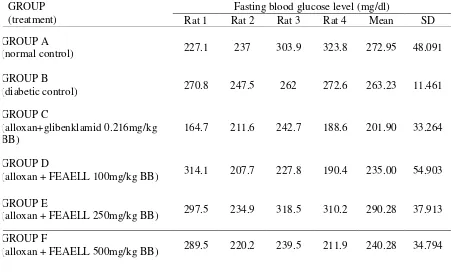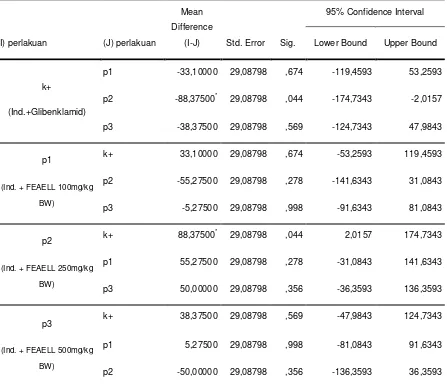181
Antidiabetic Drug Ethyl Acetate Fraction of
Leucaena leucocephala
Seed Extract in Wistar Aloxan Induced
Tri Bowo Chahyono, Afni Maulani, Muhammad Ridwan, Andiri Niza Syarifah, Arizeta Adekayanti, Hari Widada,*
Departement of Pharmacy,Faculty of Medical and Health Science ,Muhammadiyah University of Yogyakarta
*Corresponding Author, email: hariwid_ada@yahoo.com
Abstract
Diabetes mellitus (DM) is a disease with high prevalence in Indonesia. According to data of Republic Indonesia Healthy Ministry Department in 2008, the prevalence of DM in Indonesia is 5.7 % and WHO also predicts in 2025 Indonesia will be the fifth biggest country for diabetics in the world. Leucaena leucocephala is used empirically as antidiabetes, anticholesterol and intestinal worms. Flavonoid compounds in the seed were thought to reduce insulin production. The aim of this research was to determine the effect of ethyl acetate fraction from Leucaena leucocephala extract to reduce blood sugar levels in alloxan-monohydrate-induced hyperglycaemic wistar rats. The extract was prepared by maceration of dried and powdered seeds of L. leucocephala using ethanol 70 % and it was then fractionated with ethyl acetate. The experiment was carried out by controlled group post-test method using 24 male wistar rats, divided into 6 groups, i.e. A = normal control, B = negative control (alloxan), C = positive control (alloxan+glibenclamide), D = (alloxan+ethyl acetate fraction of L. leucocephala extract 100mg/kgBW), E = (alloxan+ethyl acetate fraction of L. leucocephala extract 250mg/kgBW) and F = (alloxan+ethyl acetate fraction of L. leucocephala extract 500mg/kgBW). The results were analyzed with ANOVA and post hoc test statistical assay. The results of the research showed that the ethyl acetate fraction of
Leucaena leucocephala seed extract had an effect to decrease the rats glucose blood level in the 100 mg/kg BW dosage and 500 mg/kg BW can decrease the glucose blood level (P<0,05) more than the negative control is (235.00 ± 54.903) and (240.28 ± 34.794) mg/dL.
Keywords: Alloxan, Leucaena leucocephala, Antidiabetic, in vivo assay
INTRODUCTION
Diabetes is a chronic disease. It occurs when pancreas cannot produce insulin or the body cannot effectively use the insulin. Diabetes mellitus (DM) is a disease with high prevalence in Indonesia. According to data of Republic Indonesia Healthy Ministry Department in 2008, the prevalence of DM in Indonesia is 5.7 % and WHO also predicts that in 2025 Indonesia will be the fifth biggest country for diabetics. Diabetes mellitus type 2 is reported to be 90% in all of the diabetes case in the world. Bad lifestyle and habit in
food consumption may result in diabetes. (Maulana, 2008).
One of the herbal medicines is
an active compound especially flavonoid as a therapy medicine for DM type 2.
Based on some researches Leucaena leucochepala has pharmacological effects for antiinflammation, anthelmintic and antioxidation (Nurhasanah, 2005). Super-oxide dismutase enzyme (SOD) increases in the rat injected with Leucaena leucochepala seeds extract. The increase of SOD enzyme and the decrease of
malondoaldehid (MDA) plasma is
indicative of an antioxidant activity. Increasing the MDA plasma as a product of fat to the -pancreas is related to abnormal insulin secretion. It makes hyperglycaemia. This mechanism is related to the chemical compound in Leucaena leucochepala seed as an antidiabetes. (Nurhasanah, 2005).
MATERIAL AND METHODS Plant Material
Leucaena leucochepala seeds were obtained in February in Ngebel, Bantul. The taxonomic determination of the species was done in Pharmacy Faculty Gajah Mada University. The seeds were dried in oven at 50oC. The dried seeds were powdered with a blender. The extraction method used was maceration with ethanol 70% for 7 days followed by evaporation using rotary evaporator. The thick extract was fractionated with ethyl acetate. The fractions of Leucaena leucochepala seed was thickened using rotary evaporator. The thick fraction was saved at 10oC.
Qualitative analysis
The qualitative analysis of flavonoids in ethyl acetate fraction of L. leucochepala
seed was done using thin layer
chromatography method with TLC Silica Gel 60F254 as the stationary phase and ethyl
acetate:methanol:water (10:1:1) as the mobile phase is (Mabry, 1970). The standard flavonoid compounds used were quersetin, rutin and saponin (figure 1). The standard compounds and the ethyl acetate fraction extract Leucaena leucochepala
apart from each other. The length of the track was 8 cm.
Figure 1. Qualitative analysis of flavonoids in ethyl acetate fraction of Leucaena leucochepala seeds using thin layer chromatography method.
Experimental Animals
This research used Wistar rats with body weights 150-185 g. The rats come from UD. Wistar Parangtritis, Yogyakarta. Before the treatment, the rats were acclimatized for 10 days. During treatment, the rats were given pellet AD 2 BRHOILER 80 mg per group and water ad libitum.
Induction of diabetes
Induction of diabetes in the rats was done using alloxan (2,4,5,6-tetra oxypyrimidine; 2,4,5,6-pyrimidinetetrone), a toxic glucose analogue that is able to destroy insulin-producing cells in the pancreas of rodents, causing an insulin-dependent diabetes mellitus in the animal (Lenzen, 1998). Alloxan monohydrate was obtained from SIGMA.
Anti-diabetic activity
The experiment animals were made diabetes by induction with alloxan monohydrate in water for injection at 120 mg/kg BW intra peritoneally (i.p.). Five
days after the injection, the
250 mg/dl) and the rats were then separated in 6 groups (A, B, D, E, and F groups), each consisted of 4 rats. The A group were not induced by alloxan nor treated (normal control). The B group was induced by alloxan monohydrate (negative control) and not treated. The C, D, E, and F groups were induced by alloxan and treated orally with glybenclamide 0.216mg/kgBB, ethyl acetate fraction extract Leucaena leucochepala seed (FEAELL) 100 mg/kg BW, ethyl acetate fraction extract Leucaena leucochepala seed (FEAELL) 250 mg/kg BW, and ethyl acetate fraction extract Leucaena leucochepala seed (FEAELL) 500 mg/kg respectively, starting from 11th day for 10 days. During this period, the rats were given standard chow and the drinking. On the 4th, 7th and 10th days after treatment, the rats were weighed and their blood glucose levels were measured (Kumar, 2010). fraction extract Leucaena leucochepala
seed 0.789 cm and saponin in the stationary phase.
Anti-Diabetic Study
The ethyl acetate fraction of
Leucaena leucochepala extract seeds action in rats that induced aloxan monohydrate (120mg /kgBB i.p.) as an antidiabetic agent. The value of increasing glucose blood as a diabetic control is appropriated on the rat in normal control. The ethyl acetate fraction extracts
Leucaena leucochepala seed in dose 100 mg/kg BW showed decreasing the glucose blood level significantly. The other dose, that is 250 mg/kg BW and 500 mg/kg BW can decrease the glucose blood level but it is not significant. The antihyperglycemia from ethyl acetate fraction extract
Leucaena leucochepala seed is not same with the standard medicine, Glibenklamid from Kalbe Farma product. The decreasing glucose blood effect of Glibenclamide is more better in the rats as diabetic control.
Table 1. Effect of ethyl acetate fraction extract Leucaena leucochepala seed in alloxan induced diabetic rats. Animal: Wistar Rats. Alloxan: 120 mg/kg, i.p.Extract: p.o.
GROUP (treatment)
Fasting blood glucose level (mg/dl)
Table 2. One way ANOVA analysing Leucana leucochephala
Sum of Squares df Mean Square F Sig.
Between Groups 15961,542 3 5320,514 3,144 ,065
Within Groups 20306,655 12 1692,221
Total 36268,197 15
Table. Post Hoc test of Leucana leucochephala
(I) perlakuan (J) perlakuan
Mean
Difference
(I-J) Std. Error Sig.
95% Confidence Interval
Lower Bound Upper Bound
k+
(Ind.+Glibenklamid)
p1 -33,10000 29,08798 ,674 -119,4593 53,2593
p2 -88,37500* 29,08798 ,044 -174,7343 -2,0157
p3 -38,37500 29,08798 ,569 -124,7343 47,9843
p1
(Ind. + FEAELL 100mg/kg
BW)
k+ 33,10000 29,08798 ,674 -53,2593 119,4593
p2 -55,27500 29,08798 ,278 -141,6343 31,0843
p3 -5,27500 29,08798 ,998 -91,6343 81,0843
p2
(Ind. + FEAELL 250mg/kg
BW)
k+ 88,37500* 29,08798 ,044 2,0157 174,7343
p1 55,27500 29,08798 ,278 -31,0843 141,6343
p3 50,00000 29,08798 ,356 -36,3593 136,3593
p3
(Ind. + FEAELL 500mg/kg
BW)
k+ 38,37500 29,08798 ,569 -47,9843 124,7343
p1 5,27500 29,08798 ,998 -81,0843 91,6343
p2 -50,00000 29,08798 ,356 -136,3593 36,3593
*. The mean difference is significant at the 0.05 level.
DISCUSSION
Pancreas is the primary organ involved in sensing the organism’s dietary and energetic states via glucose concentration in the blood and in response to elevated blood glucose; insulin is secreted from it (Edem, 2009). Alloxan is usually use to induce diabetes. Alloxan has destructive effect in -pancreas cell
185
The result of research showed ethyl acetate fraction extract Leucaena leucochepala seed with dose 100 mg/kg BW can decrease the glucose blood level as a mean (P<0,05) more than negative control is 235.00 ± 54.903 and 240.28 ± 34.794. Ethyl acetate fraction extract
Leucaena leucochepala seed has insignificant hypoglycaemia effect in the positive control (P>0.05) although the glucose blood level test is lower than Glibenclamide. The decreasing effect is depend on antioxidant activity of flavonoid oh it way to inhibit the free radical and
take the free radical. Leucaena
leucochepala has alkaloid, saponin and amino acid (Syamsudinhidayat, 1991). Some of the research showed there is more plant has flavonoid as antioxidant agent (Pari, 2002).
Ethyl acetate fraction extract of
Leucaena leucochepala seed can decrease hypoglycemia in 250 mg/kg BW, (P<50) than negative control that is 290.28 ± 37.913. This data are supported by statistics that showed the significant more than the positive control with significant value 0.044(P<0.05).
CONCLUSION
The qualitative test in thin layer chromatography get the Rf ethyl acetate fraction extract Leucaena leucochepala
seed is 0.789cm and Rf quersetin is 0.791cm. it showed that ethyl acetate fraction extract Leucaena leucochepala
seed has the flavonoid unsure. Ethyl acetate fraction extract Leucaena leucochepala seed has effect to decrease the rats glucose blood level in the 100 mg/kg BW dosage and 500 mg/kg BW can decrease the glucose blood level (P<0,05) more than the negative control is (235.00 ± 54.903) and (240.28 ± 34.794) mg/dL.
REFERENCES
American Diabetic Association. 2008. Dystipidemia Management in Adults with Diabetes. Diabetes Care: 27 (Supl
I). S568-71. Dikutip dari:
www.care.diabetesjournals.org.
Anoja, Yun-Pin Zhow, Jing-Tian xie et.al. 2002. Antidiabetic effect of panax ginseng, berry extract and the identification of an effective component. Diabetes. 51:1851-58. Anonim. 2004, Standard of ASEAN
Herbal Medicines, Volume II, ASEAN Countries, Jakarta, 142-150.
Depkes RI. 2008. Profil Kesehatan Indonesia. Jakarta.
Edem DO. 2009. Hypoglycemic Effects of Ethanolic Extracts of Alligator Pear Seed (Persea Americana Mill) in Rats,
European Journal of Scientific Research, 33(4), 669-678.
Gems, D., and L. Partridge. 2008. Stress-Response Hormesis and Aging: “That Which Does Not Kill Us Makes Us Stronger”. Institute of Healthy Ageing and Department of Genetics, Envi-ronment and Evolution, University Collage, London WC1E 6BT, UK. Jelodar G, Mohsen M, Shahram S. 2003.
Effect of walnut leaf, coriander and pomegranate on blood glucose and histopathology of pancreas of alloxan – induced diabetic rats, African J. Traditional, Complementaryand Alter-native Medicines, 3, 299 – 305.
Kumar SV, Kumar S., Jayantibhai HP, and Hugar S.2010. Hypoglycemic activity of ficus glomerata in alloxan induced diabetic rats: Volume 1, Issue 2, March – April; Article 004
Lenzen S, Panten U. 1998. Alloxan: History and mechanisms of action, Deabetologica, 31, 337-342.
Lenzen S. 2008. The mechanisms of alloxan and streptozotocin induced diabetes, Diabetologica 51, 216-226. Mabry TJ, Marhakham KR, Thomas MB.
1970. The Systematic Identification of Flavonoids. New York:Springer – Verlag Inc.
Maulana HDJ. 2009. Promosi Kesehatan. Jakarta: EGC.5.
Cina (Leucaena leucocephala) pada Tikus Putih, Jurnal Ilmu Kefarmasian Indonesia, Vol.3.1, hal 13-15.
Pari L, Latha M. 2002. Effect of Cassia auriculata Flowers on blood sugar level, serum and tissue lipids in eptozotocib diabetic rats. Singapore Med Journal. 43(12):620.
Prince SM, Menon VP. 2000. Hypogly-cemic and other related actions of
Tinospora cardifolia roots in alloxan induced diabetic rats, J. Ethno-pharmacol., 70, 9-15.


